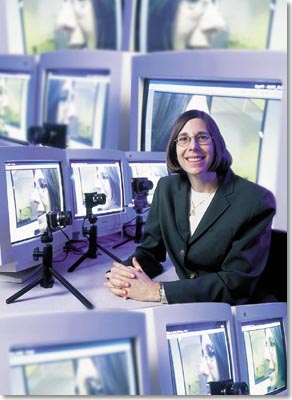Counting
on CMOS
CCDs
have long been the dominant image sensors, but CMOS
sensors are catching up fast, creating a big market
opportunity
By
Russ Arensman, photography by Keith Skelton/Blackstar
When
Sabrina Kemeny was a scientist at the National
Aeronautics and Space Administration’s (NASA) Jet
Propulsion Laboratory in the early 1990s, she and her
colleagues found the electronics industry very
reluctant to adopt a new image-sensing technology they
had developed for use in the U.S. space program.
“People said ‘no way, this will never work,’ ”
she recalls. “They were practically pelting us with
tomatoes at engineering conferences.”
 Nearly a decade later, however, the industry’s
skepticism has turned to enthusiasm, and the
complementary metal oxide semiconductor (CMOS) image
sensor technology the NASA researchers struggled to
promote is finally gaining wide acceptance. In the
next few years, CMOS sensors are expected to
increasingly displace the charge-coupled devices (CCDs)
that, until now, have dominated the $1-billion-plus
market for sensors used in products such as video
recorders and digital still cameras. Nearly a decade later, however, the industry’s
skepticism has turned to enthusiasm, and the
complementary metal oxide semiconductor (CMOS) image
sensor technology the NASA researchers struggled to
promote is finally gaining wide acceptance. In the
next few years, CMOS sensors are expected to
increasingly displace the charge-coupled devices (CCDs)
that, until now, have dominated the $1-billion-plus
market for sensors used in products such as video
recorders and digital still cameras.
CMOS sensors’ inherent power efficiency and
smaller size were initially attractive to the space
program, where every bit of size, weight and power
savings pays off in reduced launch costs. Those same
qualities, however, are proving ideal for all sorts of
battery-powered products, and are paving the way for a
whole new generation of portable imaging products such
as video- or still camera-equipped cell phones and
electronic organizers.
Today, Kemeny is CEO of Pasadena, CA-based Photobit
Corp., a company she and fellow NASA scientist
Eric Fossum founded in 1995 to exploit image-sensing
technology licensed from their former employer.
Photobit’s CMOS sensor chips are used in low-cost PC
cameras as well as high-end medical and industrial
equipment, and the privately held company’s sales
have swelled from $4 million in 1999 to a projected
$20 million in 2000.
But Photobit’s founders are not alone in pursuing
the CMOS sensor market. More than two dozen vendors
are now vying for what many hope will become one of
the chip industry’s hottest growth sectors.
Competitors range from OmniVision Technologies Inc., a
fabless Sunnyvale, CA-based company that also helped
pioneer CMOS sensors, to some of the biggest names in
semiconductors and consumer electronics, including Agilent,
Conexant, Fujitsu, Eastman Kodak,
Motorola, National Semiconductor, Philips,
STMicroelectronics and Toshiba.
Additionally, Dallas, TX-based Texas Instruments
Inc. has confirmed plans to enter the CMOS sensor
market soon, as have Japan’s big three CCD makers—Sony
Corp., Sharp Corp. and Matsushita
Electric Industrial Co. Ltd.
Cahners In-Stat Group, a Scottsdale, AZ-based
market research firm, estimates that CMOS sensors
accounted for just 7.2% of all image sensors shipped
in 1999 and 6.2%, or about $62 million, of the
industry’s $1 billion in worldwide sales. Yet by
2004, it forecasts, CMOS sensors will account for
50.8% of the units shipped, and 35.5% of revenues.
Another market-research firm, San Jose, CA-based Frost
& Sullivan, forecasts nearly 60% compound annual
growth for the worldwide CMOS sensor chip market from
1998 through 2003, compared with 6.2% for CCDs. It
expects market revenue for all types of image sensors
to reach $1.7 billion in 2003.
 
|
| “CMOS
image-sensor technology will eventually
overwhelm CCD technology.” —Brian
O’Rourke, senior analyst, Cahners In-Stat
Group |
For now, the market is relatively new and
unsettled, with no single dominant vendor. Long term,
however, as CMOS sensors increasingly become a
commodity, many current players are unlikely to
survive. And a handful of companies with the
best-performing and lowest-cost sensors are likely to
emerge as leaders. “I fully expect in the next three
to five years you’ll see a shakeout,” says Brian
O’Rourke, senior analyst with Cahners In-Stat Group.
To survive and prosper, he says, CMOS sensor makers
will have to differentiate their products with
superior performance, lower cost or specialized
features.
Photobit officials are placing their hopes for
success on their sensors’ superior performance.
“We’re not the low-price leader,” Kemeny says.
“But we have a very strong proprietary and technical
advantage over our competition.” She claims the
company’s sensors use smaller pixels, or
light-gathering elements, produce higher-quality
images and use less power than many competitors’
sensors. Photobit also boasts a strong intellectual
property arsenal, including numerous patents licensed
from NASA.
Market leaders
Market shares are difficult to measure in such an
immature, fast-changing market. Cahners In-Stat,
however, estimates that in 1999 the two leading CMOS
sensor makers were Agilent and OmniVision, each with
about one-fourth of the market (see graph). Other
leading vendors at that time included
STMicroelectronics Inc., St. Genis, France, Mitsubishi
Electric Corp., Tokyo, Japan, Hyundai
Electronics Industries Co. Ltd., Inchon, South
Korea, and Conexant Systems Inc., Newport
Beach, CA.
In many ways, OmniVision and Agilent are a study in
contrasts. OmniVision, a six-year-old fabless company
with about 75 employees, relies on foundries such as Taiwan
Semiconductor Manufacturing Co. Ltd. (TSMC),
Hsinchu, Taiwan, to build its popular CMOS sensors.
During its 2000 fiscal year, which ended April 30,
2000, the company shipped more than 4 million image
sensors and recorded sales of $40 million, almost an
eight-fold increase from its sales of $5.2 million in
fiscal 1999.
While its growth has been impressive, OmniVision is
clearly outweighed by Agilent, a diversified
$8.3-billion technology powerhouse with 46,000
employees and its own chip fabrication plants. Agilent
was spun off from Hewlett-Packard Co. in 1999
and has a long heritage in imaging, derived in part
from HP’s successful printer business. Jason
Hartlove, manager of Agilent’s imaging products
business unit in Santa Clara, CA, says the company has
been developing CMOS sensor technology since the
mid-1990s, but had only limited success with them
initially in handheld scanners. More recently, it has
sold millions of the sensors used in optical computer
mice.
Agilent introduced a line of CMOS image sensors for
cameras in September 1999, and since then has shipped
almost 8 million units. Last October, the company
introduced a second generation of improved, smaller,
CMOS sensors, as well as three image processors that
convert CMOS sensors’ signals into formats required
for computer, video or still cameras. Looking ahead,
the company is focusing on getting its sensors
designed into various portable communications
products. “We’re really looking to differentiate
ourselves in the imaging for communications market
space,” says Hartlove.
Despite the companies’ vast difference in size
and resources, OmniVision has thus far held its own,
selling millions of low-cost, highly integrated CMOS
sensors for digital cameras, security systems and
electronic organizers such as the Palm from Santa
Clara-based, Palm Inc. “We’re going after
all the high-volume, low-end opportunities,” says
Hank O’Hara, OmniVision’s vice president of
worldwide marketing.
Unlike many rivals that produce complete camera
modules—comprised of a CMOS sensor, a lens and
supporting circuitry—OmniVision has focused strictly
on image sensors. The company made a recent exception,
however, by assembling its sensors into miniature,
lipstick-sized cameras that are clipped to the bills
of umpires’ caps during broadcasts of National
Football League games to provide live “Ump Cam”
coverage.
OmniVision and other fabless sensor makers say they
are pleased with the support they are getting from
TSMC and other foundry operators, including UMC,
Hsinchu, Taiwan, and Tower Semiconductor Ltd.,
Migdal Haemek, Israel. TSMC, for instance, has just
unveiled a new 0.25-micron manufacturing technology to
produce CMOS image sensors. Developed in partnership
with Photobit and sensor maker Y Media Corp.,
Irvine, CA, it surpasses the 0.35-micron technology
touted by previous technology leaders such as Agilent,
and already has allowed Y Media to develop a
high-resolution CMOS sensor with more than 3 million
pixels.
Yet Agilent and other large chip makers with their
own fabrication plants believe they have a significant
advantage in being able to control the manufacturing
process. “I’m personally very glad to have my own
fab,” says Agilent’s Hartlove. “It’s
phenomenal how much of a difference [in sensor
performance] you can make by tuning the silicon
process.”
Robert Merritt, director of emerging markets for
Phoenix, AZ-based Semico Research Corp., agrees that
in-house fab expertise is a competitive advantage, at
least for now. “That’s still valid, as long as
we’re at the stage of trying to add performance,”
he says. He expects the advantage to fade, however,
once sensors become more of a high-volume,
standardized commodity.
CMOS vs. CCDs:
The first CMOS image sensors were produced in the
late 1960s, several years before CCDs, but they were
quickly surpassed by CCDs’ superior image quality
and lower signal noise. CCDs are still the technology
of choice in most camcorders, high-end digital still
cameras and various imaging products developed for
science, medicine and factory automation.
During the mid- to late-1990s, however, the
performance of CMOS sensors improved significantly,
thanks to advances in chip manufacturing and
signal-processing technology, which paved the way for
a new generation of CMOS sensors with less noise,
sharper pictures and better color reproduction.
CMOS sensors aren’t a simple technology, but
they’re cheaper and easier to build than their CCD
rivals in part because they require only one voltage,
compared with CCDs’ three separate voltages. Also,
while CCDs require special manufacturing processes,
CMOS sensors share the same basic technology used to
make 90% of semiconductor devices. That means chip
makers can build CMOS sensors in the same fabrication
plants in which they build most of their other digital
and mixed-signal chips, which reduces production costs
and lets CMOS sensors share new technology developed
for other semiconductor product lines.
 
|
| “They’ve
[CCD makers] been somewhat reticent to eat
their own children.” —Rudi Wiedemann,
marketing director, Zoran Corp.’s PixelCam
division |
CMOS sensors already offer significantly better
price-performance than their CCD rivals, particularly
at lower image resolutions, and the advantage is only
expected to widen. That favorable trend, plus the
electronics industry’s plans to launch an armada of
new battery-powered telecom and entertainment
products, bodes well for CMOS sensors, which typically
consume only 10% to 20% as much power as CCDs. “The
types of applications that are going to be growing at
a very rapid clip in the next five years are those
with small form factors and low power consumption,”
says Cahners In-Stat’s O’Rourke.
Although CMOS sensors can’t yet match the image
quality of the best CCDs, they are more than adequate
for products such as toys, baby monitors, PC cameras,
cell phones and fingerprint and currency readers.
O’Rourke predicts that, as CMOS devices make further
inroads into these markets, as well as into low- and
mid-range digital still cameras, North American and
European chip companies will take market share from
Japan’s big CCD makers. “The significant amount of
resources being devoted to developing CMOS
image-sensor technology will eventually overwhelm CCD
technology,” he predicts.
Not surprisingly, the CCD makers have been cautious
in embracing CMOS sensors. “They’ve been somewhat
reticent to eat their own children,” says Rudi
Wiedemann, marketing director of Santa Clara, CA-based
Zoran Corp.’s PixelCam division.
Tough technology
Despite their advantages over CCDs, CMOS sensors
have proven to be surprisingly difficult to design and
manufacture. One of the notable early casualties was
Santa Clara, CA-based Intel Corp., which
canceled its CMOS sensor development effort last year
without ever bringing a product to market. “It
wouldn’t be accurate to say that we quit the
business, since we never were in it per se. We were
just exploring this as an opportunity,” says Intel
spokeswoman Mary-Ellin Brooks.
Prasan Pai, business and marketing director for
imaging products at Conexant’s personal imaging
division in Newport Beach, CA, says several companies
that announced CMOS sensors a year or more ago still
are not producing those devices in volume. “They may
be able to design a sensor, but getting it into
production, and getting good yields isn’t easy,”
he says.
CMOS image sensors typically are built in older
fabrication plants, because the sensors don’t
require the narrow circuit widths needed for the
latest microprocessors and memory chips. Most CMOS
sensors require additional processing, however, such
as depositing dye filters to interpret color images
and tiny microlenses to increase the light collected
by each pixel. Assembly and test is another challenge,
since dust can contaminate the sensors before they are
encapsulated in translucent material, and equipment
vendors have only recently developed appropriate wafer
handling and optical test systems.
Jitesh Vadhia, group director for data conversion
and display systems at Santa Clara, CA-based National
Semiconductor Corp., notes that besides the basic
light-sensing pixel technology, CMOS sensors require
significant amounts of analog and mixed-signal
expertise for signal processing, noise cancellation
and other functions. In September, National introduced
its first CMOS imaging chips, which it claims use less
power and offer better light sensitivity than
competitors’ sensors. “The entry point is getting
more and more difficult,” Vadhia says. “It’s
taken us four years to develop all the know-how we
have today and introduce our first products.”
Graham Townsend, STMicroelectronics’ Edinburgh,
Scotland-based technical director of imaging, says
some chip makers may have underestimated the challenge
of building CMOS sensors. “A lot of the big
semiconductor companies are guilty of being slightly
arrogant,” he says. STMicro opted to buy its way
into the market in April 1999 by acquiring
Townsend’s former employer Vision Group PLC, an
Edinburgh-based company that originally spun off from
the University of Edinburgh and was one of the first
to commercialize CMOS image sensors.
 
|
| “A lot of
the big semiconductor companies are guilty of
being slightly arrogant” in terms of how
easy it was going to be to build CMOS sensors.
—Graham Townsend, technical director of
imaging, STMicroelectronics |
Townsend concedes that the acquisition initially
slowed the company’s product development efforts.
But with the integration now complete, he believes the
combination of Vision Group’s imaging technology
with STMicro’s systems and manufacturing expertise
will create a formidable competitor. “We’ve had 10
years of experience and four to five years of volume
manufacturing experience, which is exceptionally
important in doing this,” he says.
Other companies also have taken the acquisition
route in recent months, including Conexant, which last
May bought Sierra Imaging Inc., a Scotts Valley,
CA-based maker of digital image processors and
image-management software. In June, Zoran bought
PixelCam Inc., a Campbell, CA-based maker of CMOS
image sensors and integrated lens/sensor modules for
$21 million. And in August, Agilent acquired the
eCamera business unit of Palo Alto-based
PhotoAccess.com Corp.
In each case, the acquiring company wanted to
expand its CMOS imaging capabilities. Conexant, for
instance, combined Sierra’s image processors and
software with its own CMOS sensors to create a
complete set of components for mid-range digital
cameras with 1.3 million pixels, or 1.3 megapixels, of
resolution. Similarly, Zoran was able to offer a
complete camera design by combining PixelCam’s
1.3-megapixel CMOS sensors with its own digital signal
processor (DSP) core and associated hardware and
software. Agilent expanded its product line with an
image-processing chip from PhotoAccess, as well as a
camera design that lets users upload digital images
directly to the Internet to be processed into prints,
without connecting to a PC.
While Zoran, Conexant and a few other CMOS sensor
makers are taking aim at the market for mid-range
cameras with megapixel-and-above resolution, most CMOS
sensors are still used in low-cost, low-resolution
imaging devices, including toys and cameras that
connect to PCs. Toy maker Mattel Inc., of El
Segundo, CA, for instance, uses CMOS sensors in its
BarbieCam toy camera. Japan’s Nintendo Co. Ltd. of
Kyoto, Japan uses CMOS sensors in its Game Boy Camera
, which clips onto its popular handheld game machines.
In the computer industry, a variety of companies,
including Intel, are selling inexpensive digital still
and video cameras that connect to PCs. Many introduced
battery powered “dual-use” cameras this past
holiday season that can be disconnected from the PC to
take pictures elsewhere, then re-connected to download
and print the pictures.
“CMOS has really taken over the market for
under-$100 digital cameras,” says Michelle Lampmann,
market research analyst for InfoTrends Research Group
Inc. in Boston, MA. She doesn’t expect to see many
CMOS-based cameras sold until late next year in the
megapixel range, which is still dominated by CCDs.
Still, she expects CMOS sensors to make rapid inroads
into the fast-growing camera market. InfoTrends
estimates that digital still camera sales, both CMOS-
and CCD-based, will increase from 10.4 million
worldwide in 2000 to 27.5 million in 2002.
Semico Research’s Merritt says digital cameras
still are being used mainly by PC owners, and that few
are being sold in traditional camera stores.
In-Stat’s O’Rourke expects CMOS PC camera sales to
soar when major PC makers begin bundling them as
standard equipment, although that’s not likely until
costs decline from the current $50 range to $20 or
less. “Eventually they’re probably going to be
included in a package with a PC, as a mouse is,” he
says.
Pixel power
Improvements in image quality will certainly aid
the acceptance of all digital cameras. CMOS image
sensors consist of thousands, or even millions, of
tiny silicon elements, called pixels, that absorb
light and convert it into electrical signals. In
general, the more pixels a sensor has the
better-quality images it produces.
Most low-resolution sensors use the common
intermediate format (CIF) of 352 x 288 pixels, or
about 100,000 total pixels. The video graphics array
(VGA) format of 640 x 480 pixels, or just over 300,000
pixels, creates images adequate for computer screens,
but not equal to film camera prints. So-called
megapixel cameras usually consist of 1.3 million
pixels, arranged in a 1,280 x 1,024-pixel array. While
their picture quality is good, most photographers
agree that at least 2 megapixels of resolution is
needed to match the quality of film cameras.
 
|
| “I’m
personally very glad to have my own fab...It’s
phenomenal how much difference [in sensor
performance] you can make by tuning the
silicon process.” —Jason Hartlove,
Imaging Products Business Unit manager,
Agilent Technologies Inc. |
At the market’s high end, Rochester, NY-based
Eastman Kodak Co. recently introduced a CCD sensor
intended for professional studio photography with 16.6
million pixels. Just weeks later, though, Foveon
Inc., Santa Clara, CA, startled the industry by
announcing a 16.8-million pixel CMOS sensor that it
vows will produce better images than either film or
digital CCD cameras. The company, founded in 1997 by
noted semiconductor pioneer Carver Mead, is 45% owned
by Santa Clara-based National Semiconductor, which
plans to begin manufacturing the 16-megapixel sensor
in about a year, using 0.18-micron CMOS technology.
Kodak, which for years has produced image sensors
mainly for its own use, began aggressively marketing
both CCD and CMOS sensors to outside customers early
this year. Chris McNiffe, vice president of sales and
marketing for Kodak’s image sensor solutions
division, says the company will continue to focus on
high-performance “bleeding edge” imaging markets
for government, scientific, industrial and
professional photography users. But it also hopes to
make inroads into higher volume consumer markets,
particularly with its new CMOS sensors, which are
being manufactured by Schaumburg, IL-based Motorola
Inc. “Where we’ll hit the real home runs are in
some of these new markets,” he says.
The Holy Grail
Many CMOS sensor vendors are taking aim at
next-generation cell phones, which are expected to be
equipped with either video or still-camera
capabilities. Kyocera Corp., Kyoto, Japan and Samsung
Electronics Co. Ltd., Seoul, South Korea, have
already introduced hybrid handsets that combine cell
phones with still cameras. Virtually every other phone
maker is developing variations on the same theme to
take advantage of the increased bandwidth soon to be
available with third-generation (3G) wireless
services.
“The cell phone marketplace will really be the
Holy Grail for CMOS image sensors,” says National
Semiconductor’s Vadhia, noting that cell phone
shipments are expected to exceed 1 billion units
yearly by the middle of this decade. Says In-Stat’s
O’Rourke: “If you can capture even a tiny
percentage of that, it would be a huge market for
image sensors.”
Japan’s 3G cellular system is expected to begin
operating in 2001, and sensor makers are scrambling to
get their devices designed into the first handsets.
STMicro’s Townsend says prototype phones are being
evaluated by service providers and several contracts
have already been awarded, though the winners have not
yet been announced. While Japan’s phone makers are
confident that video phones will be a hit there, he
says, European and American vendors are wondering
whether still cameras make more sense in their initial
3G phones.
Besides cell phones and cameras, sensor makers hope
to put their devices into a variety of other devices,
from organizers to video conferencing systems to
special-purpose terminals for insurance adjusters.
Autos offer another potentially huge sensor market,
although it’s likely to take longer to develop.
OmniVision’s O’Hara says that eventually autos
could contain more CMOS sensors than microprocessors.
He envisions sensors to help drivers see what’s in
their blind spots, sensors to control airbag
deployment and even sensors in collision-avoidance
systems. “It’s not one of these opportunistic
markets like Web cams,” he says. “Autos will go on
forever.”
Russ Arensman is a senior editor with
Electronic Business. He can be reached at arensman@rof.net.
|
